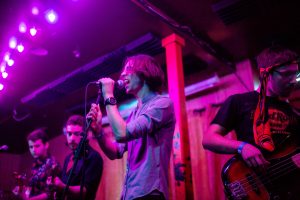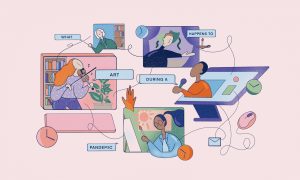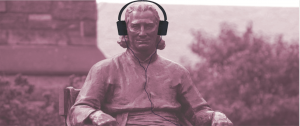At least 50 students, either seated or leaning against the back porch or balcony, had gathered in the off-campus backyard. The space was illuminated with 20 rows of string lights, sparkling like fireflies overhead. Banners and tapestry murals lined the fences, each with its own unique fluorescent design. At the center of it all was the main stage, where student artists, ranging from musical performers to slam poets, came up one by one to showcase their talents. And it was one of the most magical nights of my life.
Little did I know, I was stumbling right into one of Georgetown’s most sacred gems of student life: GUCCI. Named cheekily after the Italian luxury fashion brand, the Georgetown University Collective of Creative Individuals (GUCCI) serves as a catch-all for Georgetown’s disparate artistic community, hosting open mic showcases, art shares, comedy nights, and workshops. Its deeper purpose is to provide a home for student artists to find, share, and collaborate with each other among like-minded individuals; GUCCI is a break from the characteristic pre-professional elitism that dominates Georgetown’s student life.
Egan Barnitt (NHS ’22), current GUCCI president, has been committed to continuing the collective’s legacy since she first joined five years ago. “GUCCI [was] started the year before I got on campus in 2016 by three guys who were part of radio, but they felt like radio wasn’t, at the time, serving the artist community in the way they wanted to,” Barnitt said.
“I found them during CAB Fair, in the middle of Red Square. It sort of felt like I was walking into a scene from, I don’t know, Forrest Gump, or like, when you’re walking through a crowd and suddenly there’s all these hippies singing and drawing on the ground.”
That October night was GUCCI’s first in-person event since the pandemic’s onset. I arrived excited but not overly optimistic—not expecting more than a small audience and a short setlist of student musicians. My plan was to make a quiet entrance and then head out once I was satisfied by hearing a few performers. I ended up staying well past the concert’s end.
As a singer-songwriter, I wanted to scope out Georgetown’s music scene to see whether I could find a place for my own art. Georgetown had previously never been somewhere I considered hospitable to a thriving music and arts scene. I’ve always observed a flourishing internship culture—was there something at least somewhat comparable for the arts?
The open mic’s ambience was a place of comfort and community centered around a common love for art and performance, creation, and sharing. The experience shattered my belief that Georgetown—and Georgetown students, at that—wouldn’t be capable of putting on such an incredible event, the kind of romanticized experience I had only seen in coming-of-age movies. This was what I had been searching for at Georgetown. I knew I had found a home.
From its beginning, GUCCI was created to represent Georgetown’s free-spirited, non-conformist population. “In a school like Georgetown, it serves as a sort of pseudo-counterculture community, in a way,” Barnitt said.
“You know, you’re walking across campus and you see somebody dressed like you, or you see somebody at a concert that you recognize, and you’re sort of longing for this art community at Georgetown that, unless you find GUCCI, doesn’t really exist.”
She articulated exactly what I had been thinking: There were hundreds of Hoyas yearning for a space to be creative together, away from the harshness of the established campus culture.
Barnitt found herself in charge of GUCCI by her sophomore year, as most of the founders were seniors at the time and needed someone familiar with running events to carry on the tradition. She ran GUCCI almost entirely out of her own house in Burleith, which functioned as a sort of “DIY show space,” complete with basement concerts, showcases from touring bands, and a developing upstairs venue. “We were very much working as this sort of rogue art group,” she said.
Existing in a space away from university constraints gave GUCCI the freedom to thrive as an art community on its own, built by and for student artists to collaborate and resist conformity. That freedom, however, also came with consequences, mostly stemming from the scarcity of resources. “It was amazing, but I kind of came to realize we can’t really be reliant on the availability of a backyard, or a basement, or an on-campus apartment,” Barnitt said. “We needed a sort of stability that would last beyond me being at school.”
Anticipating this turnover, Barnitt and her roommate Kayla Hewitt (COL ’21), who has since graduated from Georgetown but is still marginally involved with performances, began the process of New Club Development, eventually being approved for official status in the spring of 2020. University recognition allowed GUCCI access to campus spaces, rentals, and funding—game changing for the organization, but unfortunately timed.
Just after this pivotal point in GUCCI’s growth as an organization, COVID-19 disrupted all aspects of campus life, particularly affecting the arts through the abrupt shift to an online environment. Consequently, Barnitt was forced to reevaluate GUCCI’s future. The club tested the waters with a few Zoom open mic nights but quickly found that it diluted the organization’s purpose as a collective.
“We took a really big hit from COVID,” she said. “And, you know, we ran events, and we had things going, but the real heart of GUCCI, it’s about people gathering. It’s about being there for people and seeing each other’s faces, and being able to yell for them in the middle of a crowd,” Barnitt said. “You can’t do that online, and we kind of became of the mind where we didn’t want to act like we could, for better or for worse.”
Since its return to Georgetown, GUCCI has made an effort to better market itself as the on-campus arts collective to incoming students. Changes in the student body have forced the club to evolve along with the artists and performers they hope to cater to; Barnitt was surprised to learn while tabling that underclassmen rarely use Facebook anymore, limiting GUCCI’s original point of contact, which had been conducive to managing a looser collective with more decentralized posts. “We’re constantly redirecting,” she said.
Now that Georgetown has resumed in-person classes for the semester, GUCCI has resumed its live open mic night concerts. Amanda Estevez (COL ’23) was one performer at the October open mic who blended their powerful vocal and keyboard skills with haunting lyrics and melodies for a performance that left the audience in awe.
“I’ve been performing since I was 10 years old, so I knew that coming into Georgetown, I needed to find a community where I could still continue that part of myself,” Estevez said. “Because it’s integral to who I am.”
I’ve felt a similar way during my time at Georgetown; as a student musician, there’s an ever-present longing for community in creation and performance. Tightly organized campus groups such as the jazz band, a cappella groups, and others don’t quite scratch the same itch as a space designed for creation and fluidity.
That need can’t be stifled by a competitive campus culture, or even a pandemic. Estevez and I commiserated in admitting we hadn’t put much work into our own music during the pandemic and that coming back to Georgetown to find a home with GUCCI was both sensational and necessary. “[GUCCI] helped me find a way to keep balance again, and to try to reconnect with a version of myself that I had not connected with in over two years,” Estevez said.
But GUCCI faces another problem even with the resumption of in-person concerts: that of transition. Barnitt is in her last year at Georgetown and has been organizing GUCCI almost entirely by herself. Much of the focus now is to find ways to consolidate responsibility and identify new leadership while retaining an open community. And, Barnitt believes, club recognition by Georgetown may not be the best vessel for achieving that goal. “I think we’re really struggling with our identity, to some degree, as to whether we want to stay with Georgetown or not,” she said. “While we’ve enjoyed the fruits of Georgetown accessibility, we don’t enjoy them that much. We don’t get that much money.”
She confesses GUCCI’s direction is a bit unknown, with the club struggling to retain artistic autonomy while still beholden to the university bureaucracy for support. “We’re kind of readjusting right now, and it’s hard, and it’s confusing, and it feels very unartistic, but it’s what’s going to keep GUCCI going, and it’s what we’ve got to do.”
Despite the challenges, Barnitt remains optimistic about the future of GUCCI and its role in shaping the underground artistic movement here on campus. Maya Cassady (COL ’23) is poised to succeed Barnitt as GUCCI’s president. She hopes to maintain the position with the spirit with which it was originally established: not as any sort of imposing authority, but as an anchor for community.
“The whole idea of GUCCI is to not have any direct leadership, which has been really refreshing for me to take over the club, in the sense that it’s really community-led,” Cassady said. “We provide the date and the space, and then everyone else brings their own little magic.”
Cassady plans to use the club’s new official identity to provide a place of respite for students looking to escape campus’s intense hustle culture.
“I think so often in a competitive environment like Georgetown, even in the arts community, it can feel like there’s only so many spots,” she said. “The whole idea is that with a community of people, you can grow in ways you didn’t know were possible.”
Georgetown can be overwhelming and merciless at times; providing a counterculture like the one offered by GUCCI is essential in diffusing the academic and professional tension that can seem inescapable. “I think GUCCI kind of whispers in your ear and goes, ‘This isn’t the real world, don’t take it too seriously,’” Cassady said. “And that can be such a nice moment to have at Georgetown, and I think it’s something more Georgetown students need to hear.”
On her way out, Barnitt has big dreams for GUCCI, though ones she acknowledges may not yet be plausible. Her biggest goal for the club, and for the university as a whole, is to come into possession of a so-called “art home”—a house that is “consistently rented out with a good basement [and] inherited music equipment,” for Georgetown musicians and creatives to call their own. A Magis Row house could provide that space for artists to collect and create, providing direct vitality for GUCCI and its mission to continue far beyond current membership. This concept has been discussed within the Black creative community on campus, to cement an art collective within Georgetown’s physical ecology for marginalized student artists.
On a smaller scale, Barnitt just wants GUCCI to be more recognizable to the student body. “My big dream is to walk by a Blue and Gray tour and hear somebody talking about GUCCI, because I feel like a lot of people don’t come to Georgetown because they don’t know stuff like this exists,” she said. “Up and beyond is what I hope for GUCCI, because we have so much room to grow, and I really hope we can take advantage of that.”
Such a trajectory is what I see in GUCCI’s future as well. At GUCCI’s most recent open mic night in November, I had the pleasure of seeing both Estevez and Cassady perform original songs for an intimate audience. Barnitt was even able to convince me to perform some of my own music for the crowd towards the end of the event—something I hadn’t done in years, but something I felt like I was meant to do that night. And that’s exactly what GUCCI is for me and so many others—a flourishing community for creation and joy, performance and emotion, love and music. I can only hope that any student like me, searching for a place to call home, can find their way to GUCCI to be part of a truly radiant family of fellow creatives.
Full disclosure: Egan Barnitt was a former Cover Editor, Maya Cassady is a Staff Contributor and Kayla Hewitt was a former Multimedia Editor of the Voice.





